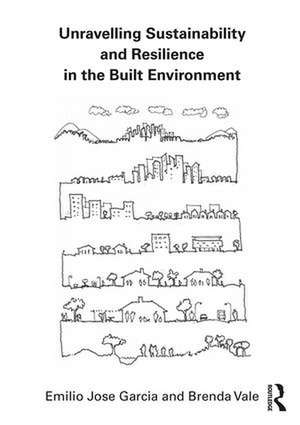Unravelling Sustainability and Resilience in the Built Environment
Autor Emilio Jose Garcia, Brenda Valeen Limba Engleză Hardback – 6 apr 2017
| Toate formatele și edițiile | Preț | Express |
|---|---|---|
| Paperback (1) | 247.40 lei 6-8 săpt. | |
| Taylor & Francis – 24 mar 2017 | 247.40 lei 6-8 săpt. | |
| Hardback (1) | 849.84 lei 6-8 săpt. | |
| Taylor & Francis – 6 apr 2017 | 849.84 lei 6-8 săpt. |
Preț: 849.84 lei
Preț vechi: 1141.68 lei
-26% Nou
Puncte Express: 1275
Preț estimativ în valută:
162.61€ • 169.78$ • 134.59£
162.61€ • 169.78$ • 134.59£
Carte tipărită la comandă
Livrare economică 04-18 aprilie
Preluare comenzi: 021 569.72.76
Specificații
ISBN-13: 9781138644021
ISBN-10: 1138644021
Pagini: 222
Ilustrații: 37
Dimensiuni: 174 x 246 mm
Greutate: 0.57 kg
Ediția:1
Editura: Taylor & Francis
Colecția Routledge
Locul publicării:Oxford, United Kingdom
ISBN-10: 1138644021
Pagini: 222
Ilustrații: 37
Dimensiuni: 174 x 246 mm
Greutate: 0.57 kg
Ediția:1
Editura: Taylor & Francis
Colecția Routledge
Locul publicării:Oxford, United Kingdom
Public țintă
Postgraduate, Professional, Professional Practice & Development, and UndergraduateCuprins
Part 1: Definitions. 1. Unravelling. 1.1. The built environment. 1.2. Environmentalism and the built environment. 1.3. A resilient built environment 1.4. Institutionalisation of definitions: sustainability. 1.5. Institutionalisation of definitions: resilience. 1.6. Unravelling sustainability and resilience. 2. Defining Sustainability 2.1. Living within ones means. 2.2. The emergence of modern sustainability. 2.3. Sustainability thinking: continuity within limits. 2.4. What is to be sustained? 2.5. Development, evolution and sustainability. 2.6. Technological development and sustainability. 2.7. Sustainability and economics. 2.8. Sustainable design. 2.9. Happiness: the ultimate goal of sustainability? 2.10. A sustainable society. 3. Defining Resilience. 3.1. Why bother with resilience? 3.2. Why is resilience an issue for architects and urban and landscape designers? 3.3. Why bother with the definition of resilience? 3.4. Early definitions. 3.5. The consolidation of ecological resilience. 3.6. The expansion of ecological resilience: from ecology to social science. 3.7.What resilience is not: misunderstandings. 3.8. Critics of the concept of resilience. 3.9. Conclusions. 4. Mapping Sustainability and Resilience. 4.1. Introduction. 4.2. Similarities. 4.3. Differences. 4.4. Emergent themes Part 2: Case Studies 5. Eco-cities 5.1. Why eco-cities? 5.2. Whitehill and Bordon, Hampshire: a UK eco-town. 5.3. Tianjin Eco-city, China. 5.4. Conclusions. 6. Heritage. 6.1. Persistence. 6.2. Identity. 6.3. Why link heritage and sustainability? 6.4. Why link heritage and resilience. 6.5. The built heritage is more than old buildings. 6.6. Braudel and Waisman. 6.7. Case study: the inheritance of San Miguel de Tucuman in Argentina. 6.8. Humble heritage: the tube houses of Hanoi. 6.9. Conclusions. 7. Compact cities. 7.1. Introduction. 7.2. Density. 7.3. Intensity. 7.4. Compactness. 7.5. The example of Auckland. 7.6. Sustainability and a compact built environment. 7.7. Compaction and resilience. 7.8. Conclusions. Part 3: Measuring Sustainability and Resilience in the Build Environment 8. Measuring Sustainability. 8.1. The issues. 8.2 Measuring sustainability with carbon footprint. 8.3 Measuring sustainability with the ecological footprint. 8.4 Measuring sustainability with indicators. 8.5 Measuring the sustainability of the built environment. 8.6 Measuring the sustainability of buildings. 8.7 Measuring the sustainability of people. 9. Measuring Resilience. 9.1 State of the art in the measurement of resilience. 9.2 How to build and urban Panarchy. 9.3 Assessing the texture of urban landscapes. 9.4 Conclusions. 10. Assessing resilience and sustainability. 10.1 Assessing an urban Panarchy in the Auckland CBD. 10.2 Assessing relative resilience in urban landscapes using discontinuities and aggregations. 10.3 Measuring relative resilience. 10.4 Measuring sustainability and resilience together. 10.5 Conclusions. 11. Conclusion. 11.1 Confusion in sustainability and resilience. 11.2 Sustainability and resilience. 11.3 Applying ecological resilience to the built environment. 11.4 Why it might be worth applying resilience to built environments. Index
Notă biografică
Emilio Jose Garcia, originally from Argentina, is a Lecturer in Sustainability at the School of Architecture and Planning in the University of Auckland, New Zealand. His current research is about the application of ecological resilience to the analysis of the morphology and context of urban landscapes. He is interested in the research of resilience in relationship with compactness, adaptability, and inequality in the built environment.
Brenda Vale is a Professorial Research Fellow at the University of Wellington in Victoria, New Zealand. Since her first publication (with Robert Vale) in 1975, The Autonomous House, she has been an influential figure in the area of sustainability as it relates to the built environment.
Brenda Vale is a Professorial Research Fellow at the University of Wellington in Victoria, New Zealand. Since her first publication (with Robert Vale) in 1975, The Autonomous House, she has been an influential figure in the area of sustainability as it relates to the built environment.
Recenzii
'In this book, Garcia and Vale question conventional wisdom about the rhetorical shibboleths that clutter discussions of ‘sustainable’ and ‘resilient’ built environments like redundant scaffolding. They’re right to do it, and they do it well as they abandon designer hubris in favour of factual analysis and rational argument as the basis for understanding and reshaping the ‘manageable complexity’ of our cities so they can work for everyone.' - Paul Downton, Ecocity Design Institute, Australia
Descriere
A primer for students and professionals, this book defines what the terms sustainability and resilience mean and how they are related to each other and to the design of the built environment.
